Cannon Street should be full of people walking, cycling, chatting, doing business, socializing and otherwise interacting. Instead, it is desolate, save for the clumps of fast automobile traffic.
By Ryan McGreal
Published August 22, 2013
This past April, photographer Mike Goodwin took a series of photographs on Cannon Street that highlighted the street's dysfunctionality as a four-lane, one-way highway blasting high-speed traffic through vulnerable neighbourhoods.
I took a walk along Cannon yesterday around lunchtime because I had heard that the City installed some zebra crossings and I wanted to see for myself if the street has gotten any better. I'm nowhere near as good a photographer as Goodwin, but I decided to take some shots to try and demonstrate what is wrong with the street.
One thing is abundantly clear: the new zebra crossings, while a welcome scrap of attention to a street badly in need of it, are nowhere near enough to mitigate the sheer oppressive brutality of this beleaguered thoroughfare.
The street design aggressively conflicts with the very idea of stopping to let a pedestrian cross the street. When the "Ride of the Valkyries" (as one friend puts it) is in full swing, there is nothing stopping drivers who feel they are on a speedway rather than an inner-city street.
Cannon Street is lined with houses and retail businesses and passes through several urban residential neighbourhoods. It should be full of people walking, cycling, chatting, doing business, socializing and otherwise interacting.
Instead, it is desolate, save for the automobile traffic, which comes in tight clumps of fast-moving vehicles interspersed with stretches of complete emptiness.
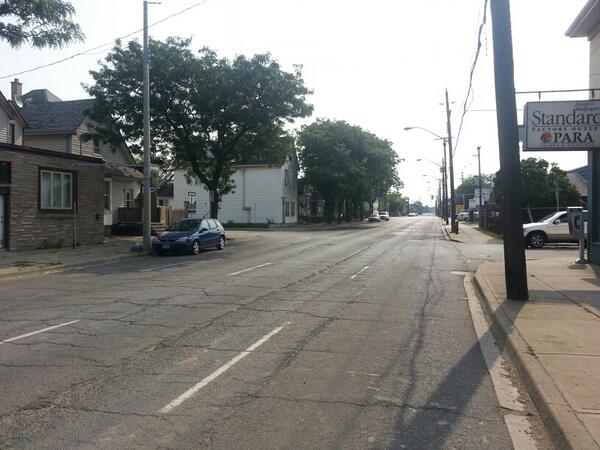
Big gaps with no traffic
There are a few important reasons for this phenomenon, all relating to the street's design:
I'm not kidding about the excess lane capacity: at Mary Street, where traffic is at its highest, Cannon carries just 16,700 a day, or 4,175 per lane. Farther east, total daily traffic tails off to just over 9,000 at Sherman.
The City should be aiming for 7-9,000 cars per lane per day, which means two lanes in total is plenty for Cannon. There's no reason not to use one of the spare lanes for a protected two-way bike lane that will connect north-central Hamilton with north-east Hamilton.
There's also no reason whatsoever for the two remaining vehicle lanes not to go in opposite directions, about which more below in the section on Wilson Street.
With the bonanza of excess lane capacity, it's no wonder so many transport trucks like to drive along Cannon. Nearly every clump of vehicles contains at least one transport truck or other heavy truck, and some contain more than one.
The following photos were taken literally within minutes of each other as I walked east. I could have taken several more.
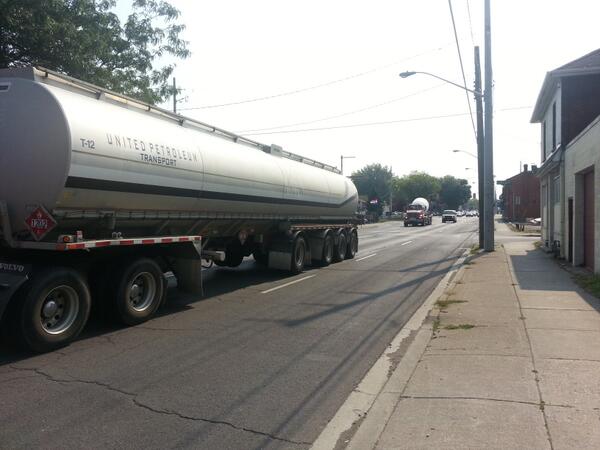
Transport trucks on Cannon

More transport trucks on Cannon
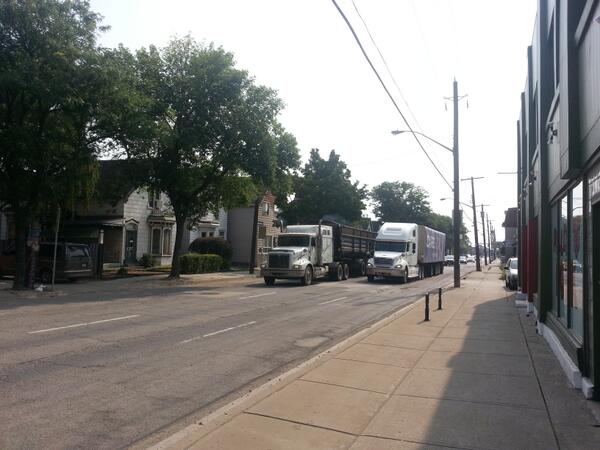
It's like a scene from a Stephen King movie
I think Graham Crawford put it best when he wrote in response to the last photo: "Photoshopped? How can two huge trucks be headed in the same direction on a four-lane street where people live? Oh yeah, Hamilton."
Nothing says "safe and healthy neighbourhood" like transport trucks and other high-speed vehicles roaring past people's homes, businesses, parks and schools.
I watched a family try to cross Cannon at Elgin, where the City has just installed a zebra crossing. Not one car stopped for them, and they ended up having to wait for the traffic to clear before they could cross.
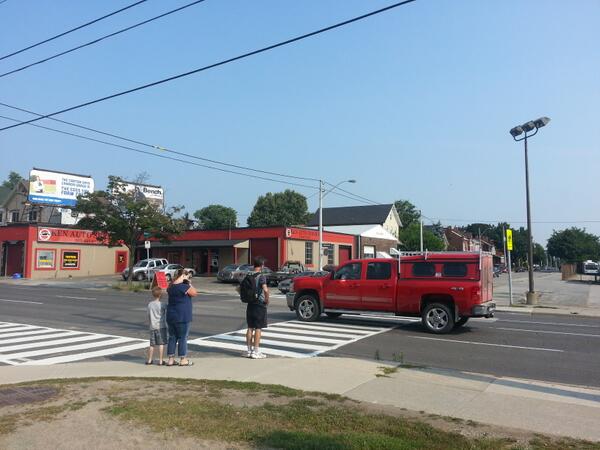
Vehicles not stopping for pedestrians on zebra crossing at Cannon and Elgin
Farther east, the City has also installed a zebra crossing at Smith, near St. Brigid's School. Presumably the crosswalk has a crossing guard during school hours, but a crosswalk is legally in force all the time.
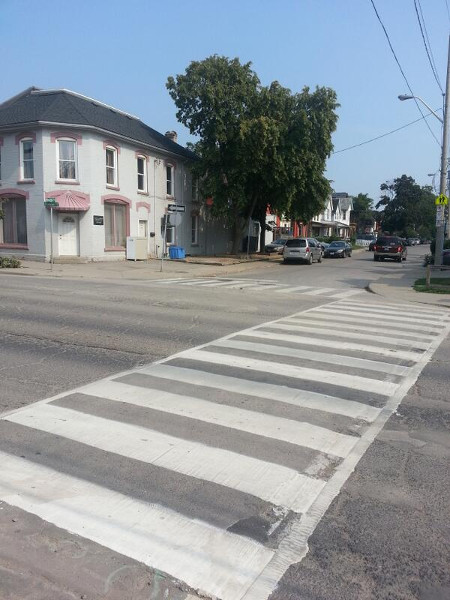
Zebra crossing at Cannon and Smith
Unfortunately, even though the crossing is marked with bright Pedestrian Crossing signs, drivers showed no sign of yielding the right of way.
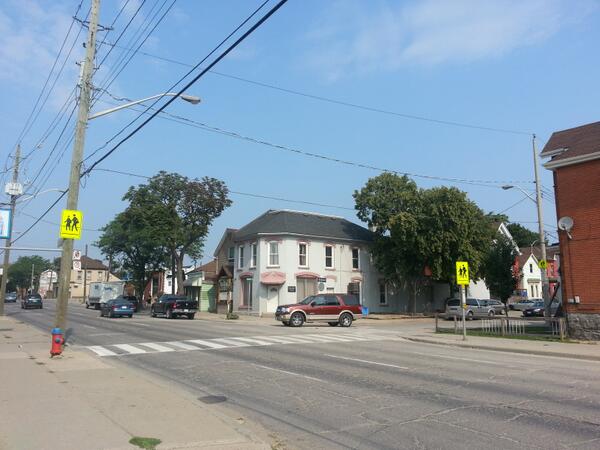
Bright signs telling drivers about the pedestrian crossing
I tried to cross at Cannon and Smith past three separate clumps of drivers, using all the techniques that are supposed to signal one's intent to cross: I leaned forward, stepped out, used hand-signals (no rude ones) and attempted to make eye contact. Of the 20 or so vehicles that passed me, not one even slowed down.
There's also a zebra crossing at Wentworth, which at least has the benefit of being at a signalized intersection so pedestrians have a chance.
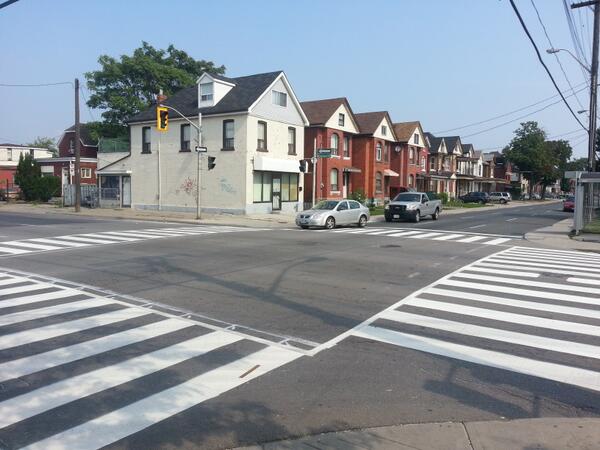
Zebra crossing at Cannon and Wentworth
Unfortunately, the next signalized intersection west of Cannon is at Victoria, 650 metres away. That is an appallingly long distance in an urban environment without a safe way to cross the street: it's actually longer than the average total distance a person will walk in a trip!
Meanwhile, one block south, Wilson street is similarly one-way, similarly excessive in lane capacity, and similarly dismal.
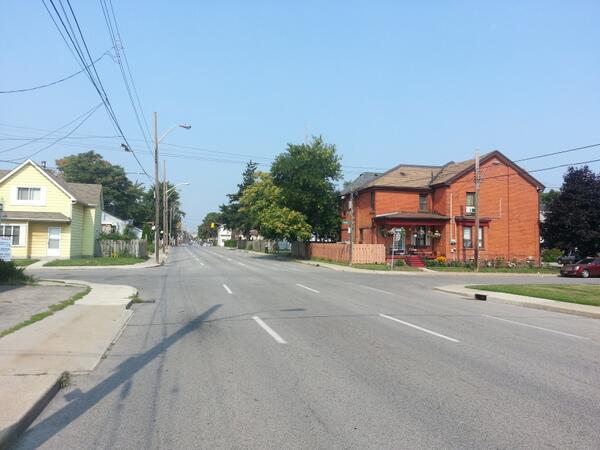
Wilson Street west of Wentworth
This is a tragic waste of scarce and valuable public space in the city. We're wasting it on useless excessive asphalt and ignoring the pent-up demand for a more active, humane, healthy and prosperous street design that other cities are already unleashing.
Wilson Street is two-way west of Victoria and one-way east of it. In the middle of a weekday, there was no traffic on either the two-way or the one-way side.
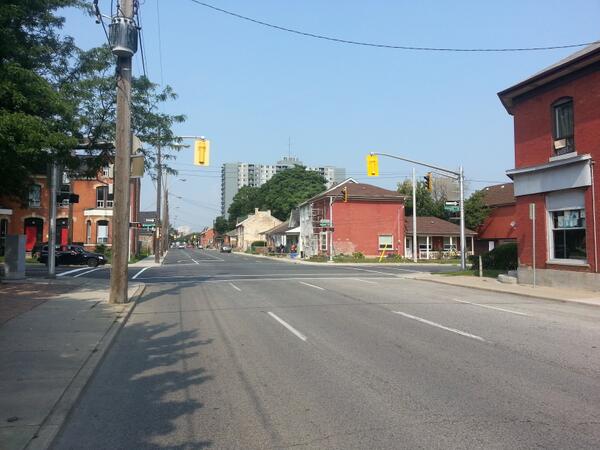
Wilson is two-way west of Victoria
Again, there is absolutely no reason for Wilson and Cannon not to be two-way along their full length.
We saw one of the benefits of two-way conversion last September when a water main burst at James and Cannon. Thanks to the fact that Wilson had been converted to two-way, traffic was able to go west on Wilson/York and bypass the damage.
Whether Cannon is two lanes westbound and Wilson is two lanes eastbound or each street is one lane eastbound and one lane westbound, they have the same lane capacity - a capacity that is more than equal to the automobile traffic these streets carry right now.
There is simply no good reason not to proceed with the two-way conversion of Cannon and the two-way extension of Wilson in a timely fashion.
From some of the discussion I've seen and participated in lately, a lot of drivers don't even seem to realize that they're supposed to stop at a pedestrian crossing. Here's what the Ontario Highway Traffic Act has to say:
When under this section a driver is permitted to proceed, the driver shall yield the right of way to pedestrians lawfully within a crosswalk.
Here is the definition of a crosswalk:
"crosswalk" means,
(a) that part of a highway at an intersection that is included within the connections of the lateral lines of the sidewalks on opposite sides of the highway measured from the curbs or, in the absence of curbs, from the edges of the roadway, or
(b) any portion of a roadway at an intersection or elsewhere distinctly indicated for pedestrian crossing by signs or by lines or other markings on the surface;
And just to be extra-clear, here is the definition of a highway:
"highway" includes a common and public highway, street, avenue, parkway, driveway, square, place, bridge, viaduct or trestle, any part of which is intended for or used by the general public for the passage of vehicles and includes the area between the lateral property lines thereof;
In other words, drivers are legally required to stop for pedestrians at any intersection, whether or not it has traffic signals, whether or not it has pavement markings, when pedestrians want to cross legally. The zebra markings don't confer any special legal status; they merely make the crosswalk more visible.
It's clear that this isn't happening in Hamilton, and I believe a big part of the reason is that our streets designed in such a way as to give predominance and priority to one mode - driving - over all others.
On streets that are more balanced in their design, like James Street North or Locke Street South, it is much easier for pedestrians to cross the street safely because drivers implicitly recognize that pedestrians have a right to be there.
On Cannon Street, the implicit message to everyone is that pedestrians and cyclists don't belong. As a result, most people don't walk or cycle on Cannon, and drivers decline to respect those few who do.
So while I welcome the City finally paying some attention to Cannon and adding a few zebra crossings, if they are serious about humanizing the street, this needs to be just the first step toward making Cannon a balanced, safe, complete, functional street for everyone.
By digbeal (anonymous) | Posted August 22, 2013 at 08:46:20 in reply to Comment 91193
What's the big deal if cars go through stop signs, as long as cars coming the other way know they're not going to stop? It's illegal is what the big deal is.
By AnjoMan (registered) | Posted August 22, 2013 at 10:46:55 in reply to Comment 91197
I think you are misinterpreting his point. If the pedestrian signals an intent to cross, cars must stop and let him cross, you are right. However, if there are big gaps between cars then what need is there for pedestrians to signal their intent to cross? If its a matter of waiting for 5 seconds until there is a gap in traffic, its unreasonable to expect cars to stop.
The reason we have these laws is because on a properly designed complete street it would at times be necessary for cars to yield the right of way in order for pedestrians to cross - and indeed, on a well designed street such as James St. North or Locke Street, it seems only natural to stop for pedestrians. The primary issue here is not one of enforcing that cars stop for pedestrians, but of designing streets so that it makes sense for them to stop. On a four-lane one way road its not better to stop for a pedestrian than to drive past them, because there is no guarantee that other motorists will follow suit. IMO the problem is primarily road design.
By brendan (registered) | Posted August 22, 2013 at 11:10:29 in reply to Comment 91216
If its a matter of waiting for 5 seconds until there is a gap in traffic, its unreasonable to expect cars to stop.
Here's why it's a big deal: A pedestrian walks at something like 4 kph. Slower for seniors. Cannon is something like 14m wide. That means it takes 12.5 seconds to cross all five lanes. In 12.5 seconds, a car travelling at 60 kph can cover just over 200m of distance. As a pedestrian, can you be sure that a car won't pop out of an intersection for the next 12 seconds? Can you see that all lanes are clear for the length of two football fields?
I see pedestrians guessing wrong on Cannon every day, and wind up playing Frogger with traffic. (Luckily I haven't witnessed an accident yet, but there have been a few close calls.) Simply put, it makes sense for cars to stop because relying on pedestrians to judge when traffic has cleared results in more dead pedestrians.
By AnjoMan (registered) | Posted August 26, 2013 at 18:17:20 in reply to Comment 91218
I see pedestrians guessing wrong on Cannon every day...
The 'wrong guess' they are making is that Cannon is a street you can safely cross without a stop-light in your favour. You can't tell drivers to travel at 50-70 km/hr on 3+ lanes (which is what the street design dictates, regardless of the posted speed limit) and also ask them to stop for pedestrians without any signals or visual aides. Its just not a place where both uses can happen. The issue not about drivers being inconsiderate, its about roadways that are designed for the wrong thing.
By AnjoMan (registered) | Posted August 22, 2013 at 08:02:59 in reply to Comment 91193
I was thinking this too... As a driver I would not stop for a pedestrian if I know there is a gap behind me, and on a 4 lane road where average speeds are >50kph, that means I wouldn't stop at all. I don't want a pedestrian to cross thinking that because I stopped for them, the guy behind me will also stop -what if the car behind me whips around on the far side of me and hits them? If there are no other cars, its reasonable to expect them to wait for me, since its a difference of seconds.
The bigger issue is that we have a street in a residential neighborhood that is designed in such a way that its not actually very safe for a motorist to stop and let a pedestrian cross.that doesn't make much sense to me, especially when the amount of traffic warrants only 2 lanes. Its a textbook example of bad design inhibiting normal usage patterns. We shouldn't be building highways where it doesn't make sense to apply the HTA doctrine w.r.t pedestrian crossings - that's what freeways are for.
By adrian (registered) | Posted August 22, 2013 at 08:03:04
On streets that are more balanced in their design, like James Street North or Locke Street South, it is much easier for pedestrians to cross the street safely because drivers implicitly recognize that pedestrians have a right to be there.
This is a good point. I work on Locke and not only do drivers often (though not always) stop for pedestrians who want to cross at the crosswalks, but they often stop to let pedestrians cross elsewhere on the street. This isn't just because drivers recognize the rights of pedestrians, it's also because there is a sense of greater proximity and community. Traffic is slow enough that it is easy to make eye contact, and when you're driving and you stop and let groups of people cross the street, you get smiles and little waves that reinforce why you stopped in the first place.
By LynnG (anonymous) | Posted August 22, 2013 at 14:37:16 in reply to Comment 91195
I live on Charlton and cross Locke frequently a Zebra crosswalks. While the majority of drivers wait until you have reached the other side before starting to move forward, a significant number almost reach you before you are two-thirds across, and I am a fast walker. Parents pushing strollers, dog walkers and seniors would feel rushed. Even with some of the infrastructure in place, an attitude change is needed. Of course, switching to two-way traffic may improve this considerably.
By Mal (anonymous) | Posted August 22, 2013 at 09:45:23 in reply to Comment 91195
Anecdotes like these reinforce my own experience amd make me wonder why the City has zebra-striped Locke South with such gusto. These measures have a positive impact, but Locke South is typically a poster-child for the civilizing effects of two-way streets, one where traffic is slow and driver-pedestrian courtesy is not extinct. Cannon, meanwhile...
By Conrad664 (registered) | Posted August 22, 2013 at 08:33:46
Well the wayt i see it . Main Cannon King Burlington streets are not desingh for residental as far i see it
By Steve (registered) | Posted August 24, 2013 at 11:45:47 in reply to Comment 91196
Then why did they build so many of those gosh darn houses on Cannon?
By -Hammer- (registered) | Posted August 22, 2013 at 20:27:49 in reply to Comment 91196
Burlington, Main and King, I agree. Cannon, no.
Burlington is a no brainer. It's in an industrial area, and it's frequent bridges and overpasses do not make it conducive to being a residential street.
Main and King, have a better case, but they are natural extension of highway 8, the only respectably fast arterial vein through the city, that crosses several commercial areas, starting with the University and Westdale that is a chain restaurant street, then encompassing Dundurn Plaza, various drive thrus and small commercial developments, the core proper, the Stadium, various restaurants & small businesses around Wellington/Wentworth which dots until the the stadium region and the Delta which is park and commerce, the Commercial area along Kenilworth which continues as it turns into Queenston and doesn't stop until it hits Hwy 8. King after the Delta runs into some brief housing before hitting Rosedale Plaza and some development on Centennial parkway before ending with housing and turning into Queenston and Highway 8.
Cannon however boasts swaths of low density housing with the occasional business. It should be converted.
Comment edited by -Hammer- on 2013-08-22 20:38:55
By jason (registered) | Posted August 22, 2013 at 10:28:01 in reply to Comment 91196
yet historic photos would indicate otherwise. Note Main East and Victoria Avenue (currently 5 lane truck freeways)
http://www.hamiltonpostcards.com/pages/s...
King and Wentworth. Looks like any number of present day Toronto residential 'high streets' full of hustle and bustle from the dense residential neighbourhoods it sits in the middle of: http://transit.toronto.on.ca/photos/imag...
We turned it into this: http://goo.gl/maps/oqpgV
By j.servus (registered) | Posted August 22, 2013 at 12:17:48 in reply to Comment 91211
Whoa, thanks for those postcards--and the clarification by contrast with google street view. That's stunning. We just moved to the city near Main and Wentworth. Every time I walk along Main I wonder how it was originally designed. That road is an affront to pedestrians. The sidewalks may be nominally five feet wide, but because of the lamp posts, it is cramped to walk even two abreast; and that's a sidewalk also shared frequently with bicyclists who are rightly afraid of venturing into the speedway (or are traveling west). Its design, and the amount of excess capacity, is outrageous.
By Conrad664 (registered) | Posted August 22, 2013 at 12:06:45 in reply to Comment 91211
yjoses streets were taken way befor Stelco took over this city and turned it into a high way in and out of the core
By jason (registered) | Posted August 23, 2013 at 15:38:11 in reply to Comment 91221
Stelco didn't do anything. We've had no leadership for 6 decades in this city.
By AnjoMan (registered) | Posted August 22, 2013 at 09:27:54 in reply to Comment 91196
Thats the whole point - they should be.
Comment edited by AnjoMan on 2013-08-22 09:28:07
By digbeal (anonymous) | Posted August 22, 2013 at 08:46:57 in reply to Comment 91196
Tell that to the thousands of people LIVING on those streets, they've had houses since long before they were turned into soul sucking highways.
By brendan (registered) | Posted August 22, 2013 at 10:28:38 in reply to Comment 91198
"Tell that to the thousands of people LIVING on those streets, they've had houses since long before they were turned into soul sucking highways."
Repeated for emphasis. Every time I drive down Cannon, past hundreds of houses who's front lawns have been turned into a freeway, I think of all of that lost wealth. Cannon was once a thriving neighbourhood - it can be again!
By Gord (anonymous) | Posted August 22, 2013 at 08:49:15
You don't want vehicles stopping too much. Idling vehicles emit more unburned hydrocarbons - and the bulk of Cannon St. addresses are residential, family homes.
The streetlights are timed so there is assuredly a break in the traffic that permits pedestrian street crossing. In regards to pedestrian rights and a driver's legal responsibility to permit pedestrians the right of way, as a pedestrian I find it safer and more prudent to cede the right of way to the 1 ton chunk of steel traveling at 50km/h, and wait patiently for my opportunity to cross the street safely.
In any case, I agree that Cannon St. is a terrible design. The sidewalks are too narrow to cut metered parking into the street for the small businesses that do reside there (the ones still open). You could make it two way but then you'd be clogging an artery and there would be even less opportunity of stopping to support the businesses. I don't know.
If I am to make one point - look both ways before crossing. Never assume a driver sees you or knows what you're doing, and never assume you know what the driver is doing.
By Brendan (registered) | Posted August 22, 2013 at 10:38:12 in reply to Comment 91199
"You don't want vehicles stopping too much. Idling vehicles emit more unburned hydrocarbons - and the bulk of Cannon St. addresses are residential, family homes. "
That's just not true. Stop repeating it. An idling car uses far less gas than one speeding by at 60 kph, and the number of cars passing each house per hour lowers as we reduce the average speed. That's why the highest pollution in Hamilton is next to the 403, QEW and Linc. (see page 19)
Comment edited by Brendan on 2013-08-22 10:43:52
By ScreenCarp (registered) | Posted August 25, 2013 at 11:46:19 in reply to Comment 91215
Oh nonsense. Pollution is bad near the highways because of the sheer number of vehicles, not because of their speed. You do not want lines of cars/trucks idling outside your front door.
By brendan (registered) | Posted August 28, 2013 at 16:51:11 in reply to Comment 91355
You forget that speed and number of vehicles are linked. Slower speed roads = less vehicles = less pollution, (even if the contribution of each one is slightly higher due to more stop-and-go, a fact that is having less and less impact as hybrids, EVs and start-stop systems grow in popularity).
By AnjoMan (registered) | Posted August 22, 2013 at 09:33:48 in reply to Comment 91199
You don't want vehicles stopping too much. Idling vehicles emit more unburned hydrocarbons...
That's funny because right now they have to idle for a whole stop-light cycle in order for pedestrians to cross safely.
as a pedestrian I find it safer and more prudent to cede the right of way to the 1 ton chunk of steel traveling at 50km/h
This is exactly the problem - we have not only 1-ton chunks of steel but also 17-ton chunks of steel traveling at not just 50km/h but over 50km/h on a road where pedestrians are legally allowed to cross without any signals. Its either a road or a freeway, it can't be both.
You could make it two way but then you'd be clogging an artery
It's been proven that this is untrue
Comment edited by AnjoMan on 2013-08-22 09:41:51
By Canning (anonymous) | Posted August 22, 2013 at 09:42:03
I think every councilor needs to spend a day walking along this street before they vote on Farr's bike lane motion. For the ones that will vote against it I want them to know inside their skin what sentence they're imposing on the people who live on and around Cannon.
By jason (registered) | Posted August 22, 2013 at 10:29:50 in reply to Comment 91204
to them it's simply the price one pays for living in 'that part of town'. If they want nicer quality of life they should move to all of our surrounding communities, like 99% of city hall employees have.
By howtofix (anonymous) | Posted August 22, 2013 at 10:01:07
Should we be trying to get the bike lanes AND two way conversion at the same time? I'm afraid they'll put in bike lanes and decide it's "better enough" and doesn't need anything else for another 20 years, but then I hear Maria Pearson saying we should talk about bike lanes and conversion at the same time and wonder if she isn't just stalling so they don't have to do anything.
I wish we could trust council to do the right thing.
By Kevin Love (anonymous) | Posted August 22, 2013 at 10:02:09
I support Councillor Farr's bike lane motion and will write to him saying so.
Right now, to cross the street I always put up my right arm with right hand palm outward in the "stop" signal position. This usually works, but if I do not do this car drivers will usually illegally fail to stop.
By Fuggedaboudit (anonymous) | Posted August 22, 2013 at 10:08:44
Hart Solomon used to brag about Cannon as a great engineering feat that got huge numbers of cars and trucks through downtown really fast. As if that's something to be proud of. Note to any engineers who care-- Cannon St. is not something to be proud of, it's something to be ashamed of. Now FIX IT.
By jason (registered) | Posted August 22, 2013 at 10:31:16
I can just see the bubbly being popped open at city hall after reading this article. They're surely darn proud of their engineering feat. Hamilton: Best Place to Raise a Glass to the 70's.
By PearlStreet (registered) | Posted August 22, 2013 at 12:40:58
That is my house at the corner in the picture of Wilson and Victoria Ave N. I have sent letters to that regard, extending two way traffic along Wilson. It becomes a drag strip as it opens up into more lanes, right beside a park with children playing. Let me send anyone interested pictures of a child that was hit recently at that intersection to push this argument! This area needs calming!
Comment edited by PearlStreet on 2013-08-22 12:55:09
By Gabriel (anonymous) | Posted August 22, 2013 at 12:54:28
Ryan,
Part of the problem with the signs posted is that Hamiltonians have been trained that those yellow signs designate School Zones. They are warning signs only and have no basis in traffic law whatsoever. When I inquired about the speed limits to the HPS, an officer told me they are cautionary only. Only White signs can be applied to the Highway Traffic Act.
They say it takes a minimum of 30 days to change a behaviour, but this being Hamilton we know it's much longer.
By AnjoMan (registered) | Posted August 28, 2013 at 18:38:57 in reply to Comment 91226
I don't think its a matter of what color the signs are. Drivers routinely ignore actual speed limit signs although they are always white with black text - they do it because it feels natural. On a smooth, straight, recently paved freeway with little to no traffic, it feels natural to drive over 120km/hr, even if the posted, 'air-patrolled' limit is 100, because the road is designed to allow it. Likewise on a 4-lane one-way roadway like Cannon, which is overbuilt for the amount of traffic and is pretty straight, it feels like the posted speed limit is actually the minium.
There is nothing special about Hamiltonians in the way they are able to read signs or how quickly they adapt to road conditions. Drivers will respond to real signals like how wide the road is, how many lanes there are, what they are driving past (i.e. busy sidewalks, parked cars). They don't respond to changing signage in a significant way because signs are not significant changes to a road.
By Go Go (anonymous) | Posted August 22, 2013 at 13:29:16
I live on Wentworth St N just below Barton. When I walk to work (Wellington/King) I avoid using Cannon at all because you can't breath from all the exhaust and dust flying around! I will take King William across to Wellington, a much nicer walk!
And Cannon isn't the only problem... Wentworth has its fair share of transports and speeding cars (on a narrower road) zipping down to Cannon... and right pastCathy Weaver to boot. If one of those trucks ever lost control it would be horrific! I just don't understand it. Imagine a transport careening into the playground at the school or into one of the residential houses there.
It just kills me,,, maybe literally one day.
By kevlahan (registered) | Posted August 22, 2013 at 13:29:55
The weirdest thing about pedestrian crossings is how municipalities in Ontario themselves (not just Hamilton) seem intent on publicly misinterpreting the Highway Traffic Act.
Here is what Kingston says, which is obviously completely false and seems to be directly inspired by Hart Solomon's Hamilton (mis)interpretation, starting in about 2000:
"Pedestrian laws in Ontario are unique with respect to other provinces in Canada. The Highway Traffic Act of Ontario does not require motorists to stop for pedestrians at crosswalks marked only with white lines and/or signage. The Act takes precedence over any potential local by-law. The City does not install these types of "crosswalks" as they could create potential safety issues since pedestrians might mistakenly believe that they have the right-of-way over vehicles.
The City of Kingston is working with other municipalities and the Ontario Traffic Council to propose "pedestrian friendly" changes to the Highway Traffic Act of Ontario. The revisions would provide right-of-way to pedestrians over vehicles at crosswalks designated with pedestrian signage and white "ladder" pavement markings. The Ministry of Transportation Ontario is reviewing the proposed revisions but approval of the changes is uncertain at this time.'
http://www.cityofkingston.ca/residents/r...
What is going on here? Are municipal traffic engineers deliberately trying to mislead residents about the contents of the Highway Traffic Act, or have they just assumed that because motorists don't stop there must be something in the Highway Traffic Act to sanction this behaviour?
It is one thing to say that a certain section of the Act has not been enforced for years, and so it is unwise to install pedestrians to cross at unsignalized intersections. It is quite another to deliberately mislead the public about what the Act says on the issue!
In a response another commentator's recent experience in Vancouver, I was born and raised there (although I moved away in 1990). I recently spent a week back in Vancouver, and decided to see if driver behaviour has changed with respect to pedestrians.
In general, it is still night and day compared to Ontario. Almost all motorists will stop for pedestrians crossing at any intersection as soon as they step off the curb on busy streets such as Denman, South Granville and Marine Drive in West Van. You may encounter the occasional dangerous, rude or distracted driver, but that is definitely the exception.
Comment edited by kevlahan on 2013-08-22 13:31:35
By Keith (anonymous) | Posted August 22, 2013 at 22:08:44 in reply to Comment 91229
So what's the judicial precedent of pedestrian issues related to the Act? (aka. the thing that matters)
By kevlahan (registered) | Posted August 22, 2013 at 14:01:43 in reply to Comment 91229
I should probably be a little more generous (or at least comprehensive) in my comments on the deliberately misleading crosswalk policy of many municipal Ontario traffic engineers.
The source of confusion about pedestrian crosswalks in Ontario is due to two distinct parts of the Highway Traffic Act,
The duty of drivers to yield to all pedestrians legally crossing at a crosswalk, where a crosswalk is the extension of the sidewalks at any intersection regardless of what signs or markings it has, even if it has none at all. 'Legally crossing' obviously does not include pedestrians crossing against a red light, for example.
The regulations of the Act define a special case of a crosswalk, called a 'crossover', which is indeed quite peculiar as it only ever seems to to have been used extensively in Toronto. This beast is a set of white lines indicating where the crosswalk is, together with illuminated overhead yellow and black signs with an amber light with push button, street signs (white with a black X) and another set of pavement markings warning motorists that there is a crossover ahead. This 'crossover' has not been widely adopted because it is so complicated, with its panoply of signs and lights that it usually makes more sense to simply install a traffic light (even though a pedestrian activated traffic light currently costs $125k, at least in Hamilton).
Here is an image from the Driver's handbook:
http://www.mto.gov.on.ca/graphics/englis...
As you can see, these full 'crossovers' are pretty rare outside Toronto!
So the traffic engineers are right that if a City wants to specially mark a crosswalk, the Act (or at least the regulations) provide only the 'crossover' solution. However, it is obvious that crossovers are not the only intersection drivers must yield to pedestrians, otherwise we wouldn't have school crossings!
However, the traffic engineers are dead wrong and highly irresponsible to claim that motorists don't have to yield to pedestrians in a crosswalk (i.e., an intersection). The panoply of signs constituting a 'crossover' is simply an extra reminder to motorists to yield, it is not open season on pedestrians at other intersections, as is made crystal clear in the sections of the HTA that Ryan quoted.
It is simply unconscionable for traffic engineers to state that motorists have no duty to yield to pedestrians crossing at an intersection. To put it bluntly, this is either incompetence or an outright lie.
Comment edited by kevlahan on 2013-08-22 14:05:20
By banned user (anonymous) | Posted August 22, 2013 at 14:09:02 in reply to Comment 91233
comment from banned user deleted
By sally forth (anonymous) | Posted August 22, 2013 at 14:20:42 in reply to Comment 91234
I don't see the contradiction. If you're waiting to cross and a car approaches, the car should stop for you. If you get there when the car is already coming right up, you should wait for it pass.
By banned user (anonymous) | Posted August 22, 2013 at 14:22:45 in reply to Comment 91236
comment from banned user deleted
By kevlahan (registered) | Posted August 22, 2013 at 14:56:48 in reply to Comment 91237
Waiting for a 'safe gap' does not mean that pedestrians should cross such that motorists never have to yield (i.e. stop) for pedestrians.
It means that pedestrians must wait for a large enough gap in motor vehicle traffic that an alert motorist can come to a safe and controlled stop to fulfill their duty to yield to the pedestrian in the crosswalk. In practice, waiting for a gap will often mean that motorists do not need to stop. But not always, especially on busy streets.
Here is what the Ontario Traffic Council website says on the issue (i.e. the official voice of Ontario municipal traffic engineers), which tells us how traffic engineers actually design streets and signals, and how they interpret the Act and regulations:
"Uncontrolled crossings are locations where pedestrians cross without the aid of traffic control measures and a dedicated pedestrian right-of-way. At these locations, pedestrians need to wait for safe gaps in traffic before attempting to cross on the roadway while drivers must always be in control of their vehicle and have due concern for the safety of other road users, including pedestrians. At an uncontrolled location, the pedestrian must not enter the roadway if vehicles are not able to stop and drivers must make every effort to avoid a collision. This dual responsibility puts the onus on both road users for each other's safety as there is no prescribed right-of-way. As pedestrians are the more vulnerable road user, they must take extra care to ensure that all approaching drivers have seen them and have or will be able to stop safely, before ocnsidering entering the roadway. "
http://www.trafficwiki.org/index.php/Cla...
The bizarre aspect is that the although Act is crystal clear on who has the right of way at uncontrolled pedestrians crossings, traffic engineers persist in claiming there is no right of way, even thought the Act is indeed the ultimate authority.
This confusion is highlighted in another part of the Ontario Traffic Council website that points out that
'In Ontario, the Highway Traffic Act defines crosswalks without distinction between controlled and uncontrolled crossing locations. In spite of this, the rules of the road are distinct. In the absence of stop/yield signs, pedestrian crossover, or half or full traffic control signals, pedestrians at an uncontrolled crossing location are required to wait for gaps in vehicular traffic before crossing. '
http://www.trafficwiki.org/index.php/Ped...
In other words, as I have state previously, conventional motorist behaviour in Ontario (unlike BC and other provinces) has come to ignore their duties at uncontrolled pedestrian crosswalks under the Act and traffic engineers have accommodated what motorists actually do, rather than what they should do (hence the "in spite of"). This is strange as everywhere else, as far as I can tell, the "rules of the road" are determined by what the Act says! Why the exception for pedestrian crossings?
The ultimate solution is to use enforcement, education, and new standard (i.e. economical unsignalized) crosswalk markings to bring driver behaviour back into line with the Act.
However, municipal traffic engineers shouldn't lie to us: the Act does not distinguish between controlled and uncontrolled crosswalks with respect to the duty of drivers to yield to pedestrians, and the current "understanding" is dangerous and has no grounding in the Act.
As Ryan and other have stated, the problem is precisely that municipal traffic engineers long ago stopped treating uncontrolled pedestrian crosswalks according the the Act, and decided simply to accept drivers flouting the Act. This needs to stop.
Comment edited by kevlahan on 2013-08-22 15:00:08
By kevlahan (registered) | Posted August 22, 2013 at 17:20:09 in reply to Comment 91246
After digging a bit more, I am even more confused by this statement on the Ontario Traffic Council (municipal traffic engineers association) website:
"In Ontario, the Highway Traffic Act defines crosswalks without distinction between controlled and uncontrolled crossing locations. In spite of this, the rules of the road are distinct."
I had thought they were using "Rules of the Road" in an informal sense to mean driving conventions, rather than rules as set out in the Act. However, Part X of the Act is actually called "Rules of the Road"
http://www.golishlaw.com/statutes/oh08ht...
and it states, consistent with the rest of the Act:
"Yielding to pedestrians (7) When under this section a driver is permitted to proceed, the driver shall yield the right of way to pedestrians lawfully within a crosswalk. R.S.O. 1990, c. H.8, s. 144 (7)."
So what exactly are these mysterious "Rules of the Road" if they are not the "Rules of Road" as defined in Part X of the Act? Where are they codified? Or are they simply passed on as conventions (i.e. "pedestrian treatments") from one generation of traffic engineers to the next? The traffic engineers' consideration of uncontrolled crosswalks is confused and contradictory, and doesn't seem grounded in either law or regulation. See also, http://trafficwiki.org/index.php/Uncontr... where the problem of uncontrolled crossings is described as "lack of formal right-of-way designation for pedestrians", which makes it sound as if it is the lack of reminders to both pedestrians and motorists of who has the right of way that is the problem, not that motorists don't have a duty to yield. And further, "The presence of enhanced pedestrian features at uncontrolled crossings may create a false sense of confidence on the part of pedestrians, particularly children, who may enter the crossing expecting that approaching drivers will see them and stop. " In other words, pedestrians might actually expect motorists to obey the Highway Traffic Act, as they do in other provinces!
Comment edited by kevlahan on 2013-08-22 17:49:36
By sally forth (anonymous) | Posted August 22, 2013 at 14:25:22 in reply to Comment 91237
I don't find that anywhere in the Act. Source?
By banned user (anonymous) | Posted August 22, 2013 at 14:30:40
comment from banned user deleted
By Control It (anonymous) | Posted August 22, 2013 at 15:05:19
While we're waiting for Hamilton drivers to learn how to drive the city needs to install a pedestrian activated crosswalk at Cannon and Smith. Why isn't Bernie fighting for one? This is his ward!
By Steve (registered) | Posted August 25, 2013 at 12:31:33 in reply to Comment 91250
Here's you answer. Nothing happens in "Bernie's Ward" unless Bernie wants it, period.
By Go Go (anonymous) | Posted August 23, 2013 at 15:41:45 in reply to Comment 91250
Bernie fight? BHABHAHBAHBHBAHBHA
By Nope (anonymous) | Posted August 23, 2013 at 19:23:39
I'll give you a reason why Cannon shouldn't be converted: Because people have to commute outside the city to work. Cannon is an easy and fast way to get from east of downtown to the 403.
By j.servus (registered) | Posted August 23, 2013 at 22:17:28 in reply to Comment 91305
If we made Garth north of Fennel one way southbound, and took TWO LANES off Cannon, Garth would still carry more vehicles per lane.* Why don't we make Garth one way and convert Cannon? (*Assuming traffic volume remains constant, which, of course, it would not.)
By math (anonymous) | Posted August 23, 2013 at 20:49:33 in reply to Comment 91305
And this, my friends, is why Hamilton taxes will go up faster than any real city's. The more of lower Hamilton that remains a terrible place to live, the higher all of our taxes will be. Enjoy your commute, "Nope"!
By kevlahan (registered) | Posted August 25, 2013 at 14:58:57
It is often claimed that lower average speeds (e.g. due to lowering the speed limit from 50 km/h to 30 km/h or introducing traffic calming) makes streets safer, but at the price of higher pollution.
This seems intuitive since it is based on the idea that engines are more efficient at higher speeds and that at higher speeds a car passes more quickly through the neighbourhood.
However, research suggests that lower average speeds combined with appropriate traffic calming to reduce agressive driving (fast braking and acceleration) actually leads to lower emissions. This is because the greatest factor determining emissions is not vehicle speed, but the amount of rapid acceleration. In addition, traffic calming can reduce pollution in the longer run by reducing the number of vehicle trips on the road as it becomes a less desirable "shortcut" and walking and cycling become more attractive.
Not all traffic calming is equal, however, from the emissions point of view.
Speed humps can increase emissions (due to slowing and accelerating), so it is better to implement traffic calming that encourages a uniformly lower speed (like narrower lanes or fewer lanes). Stop signs are also bad, as they mean more decelerating and accelerating. Traffic circles are better than traffic lights and stop signs for emissions (and well-designed traffic circles can effectively calm traffic by smoothly slowing it), but can pose problems for crossing pedestrians if not properly designed (e.g. if they don't slow traffic to pedestrian safe speed).
The current fast, one-way under capacity multi-lane streets like Cannon are the worst of all worlds. They encourage dangerously high speeds (for pedestrians and cyclists), and the high speed clumps of traffic encourage agressive acceleration and deceleration as motorists rapidly accelerate to try to catch the green wave and keep up with the cohort of fast-moving traffic.
Reference: http://www.theguardian.com/environment/2...
Comment edited by kevlahan on 2013-08-25 15:00:28
By -Hammer- (registered) | Posted August 26, 2013 at 15:55:24
Regretably, Ward 2 has spoken on this issue, and it's not high on the priority list.
http://www.cbc.ca/hamilton/news/story/20...
Complete Canon Street - Not funded with only 226 votes, although to be fair, I suspect the "Compromise Solution" city staff put forward on the ballot might have had something to do with it.
Comment edited by -Hammer- on 2013-08-26 15:55:41
By Pxtl (registered) - website | Posted August 26, 2013 at 19:46:00 in reply to Comment 91403
Almost every traffic issue is at that bottom there... one crosswalk got approval. That's kinda surprising.
By -Hammer- (registered) | Posted August 27, 2013 at 00:01:55 in reply to Comment 91412
It does and it doesn't. The tunnel at Hunter and McNab is exclusively a pedestrian path. However, given that the sidewalk ends on the tunnel side (and really should to discourage access to the rail tunnel) preventing you from walking west, and it's likely people will cross McNab to reach Jackson Square/The Transit terminal it makes sense. Also given the weight that the Durand neighbourhood assoc. has, it's not surprising.
Hunter and Park, you typically aren't crossing Hunter to get to the city hall parking lot. The crossing lights at Bay are also not a huge distance if you are heading to main and if you are going east, you are already being funnelled that was via the far safer Hurst Place and then the MacNab tunnel.
Canon needs a much larger overhaul then one crossing at Mary and Canon, and that's hopefully likely to occur next year to time it with the stadium being up, the next participatory budget and Farr's current proposals.
The Charlton and Wentworth one surprises me though. That blind corner people whip around is deadly. However Corktown doesn't have the same amount of clout as Beasley and Durand and might be thinking we can pass the buck to Ward 3 on that one.
Another proposal I wanted to see was a pedestrian tunnel from Corktown Park to West Ave to link it with Carter Park instead of having people cut through the chain link fence and cross the rail lines. Also better lighting between Corktown Park and Stinson along the rail trail.
Comment edited by -Hammer- on 2013-08-27 00:11:37
By kevlahan (registered) | Posted August 26, 2013 at 16:03:53 in reply to Comment 91403
To be fair, staff didn't come up with the compromise solution, residents did via the assembly representatives.
Perhaps Cannon street will be on the compromise solution next year ... this is intended to be an annual process.
By -Hammer- (registered) | Posted August 26, 2013 at 16:24:45 in reply to Comment 91404
That is true, and of course Farr is still trying to get bike lanes installed and that Stadium rework plan calls for conversion of Cannon St which gives hope on that front.
By Fred Street (anonymous) | Posted August 28, 2013 at 18:07:43
Cannon W of Mary= 4 lanes 1-way, accommodating 16,700 total traffic volume @ 4,175/lane
Cannon W of Sherman = 4 lanes 1-way, accommodating 9,100 total traffic volume 2,275/lane
Cannon E of Sherman = 2 lanes each way w/curb parking, accommodating 10,800 total traffic volume @ 2,700/lane
http://raisethehammer.org/article/1731/data_show_traffic_volume_argument_for_one-way_streets_is_false
Cannon is already two-way east of Sherman and yet accommodates 15% more traffic than the 4-lane one-way stretch of Cannon between Sherman and Mary, suggesting that there is ample capacity for two-way conversion on that 2km stretch. As most of the residential density along Cannon appears east of Wellington, and since that stretch has demonstrably more lane capacity than is needed, it would seem like a good idea to target Wellington to Sherman as a priority conversion.
BTW, does anyone know how "Complete Cannon St. W" ranked in the Ward 2 participatory budgeting sessions?
By Fred Street (anonymous) | Posted August 28, 2013 at 18:18:29 in reply to Comment 91488
Oh, bother. Found it.
The "compromise" seems weighted to win because it's the easiest opt-in: You check a box to vote for 21 proposed projects.
The alternative, ranking up to 25 proposals in order of preference, seems far more time-consuming. In light of the "up to", I'd be curious to know if PB staffers afforded different weight to ballots where fewer projects were supported by residents (eg: If someone only voted for "Complete Cannon St. W", would it carry the weight of 25 #1 votes?). Encouraging signs of civic engagement, in any event.
You must be logged in to comment.
There are no upcoming events right now.
Why not post one?